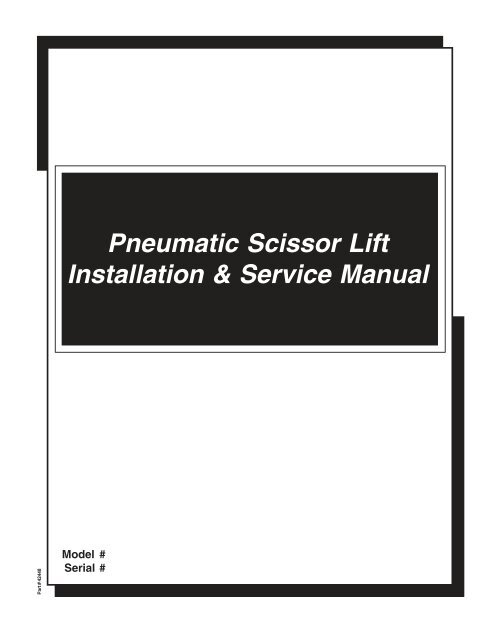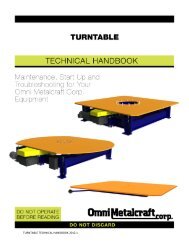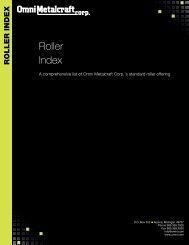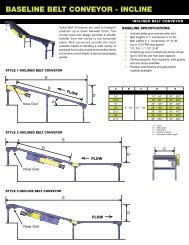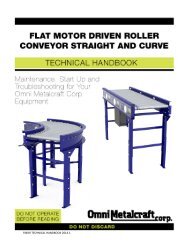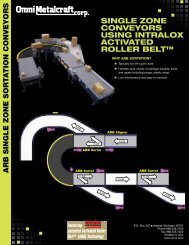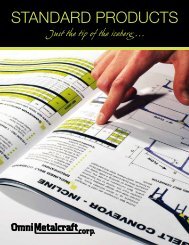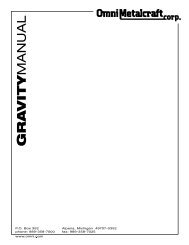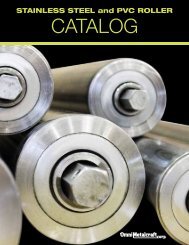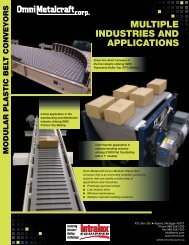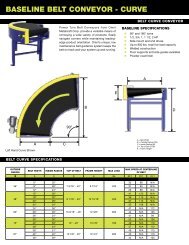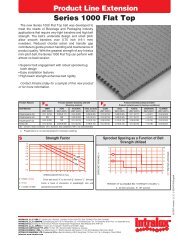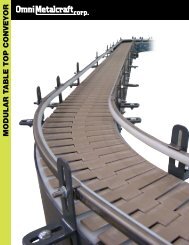Pneumatic Scissor Lift Manual.pdf
Pneumatic Scissor Lift Manual.pdf
Pneumatic Scissor Lift Manual.pdf
You also want an ePaper? Increase the reach of your titles
YUMPU automatically turns print PDFs into web optimized ePapers that Google loves.
<strong>Pneumatic</strong> <strong>Scissor</strong> <strong>Lift</strong>Installation & Service <strong>Manual</strong>Part # 42448Model #Serial #
CONTENTSPageResponsibilities of Owners and Users 1Warnings 2Safety Labels - <strong>Scissor</strong> <strong>Lift</strong> 3Installation Instructions 4Installation Instructions - Pit Mounted 5G:\shared\Ed..DoNotRemove\Std<strong>Manual</strong>s\<strong>Scissor</strong><strong>Lift</strong>s\<strong>Pneumatic</strong>Sciss<strong>Lift</strong>12-02Pit Layout Drawing 6Operating Instructions 7General Information 8Maintenance Instructions 9<strong>Pneumatic</strong> Schematic 11Trouble Shooting 12
RESPONSIBILITIES OF OWNERS & USERS1Inspection and Maintenance: The lift shall be inspected and maintained in proper workingorder in accordance with this manual and safe operating practices.Removal From Service: Any lift not in safe operating condition shall be removed fromservice until it is repaired to the original manufacturer’s standards.Repairs: All repairs shall be made by authorized personnel in conformance with themanufacturer’s instructions.Operators: Only trained and authorized personnel shall be permitted to operate the lift. Theymust understand to be alert to safety hazards during all operations.Before Operation: Before using the lift, the operator shall have:1. Read and understood the manufacturer’s operating instructions and safetyrules and been trained by a qualified person.2. Inspected the lift for proper operation and condition. Any suspect item shallbe carefully examined and a determination made by a qualified person as towhether it constitutes a safety hazard. All unsafe items shall be correctedbefore further use of the lift.During Operation: The lift shall be used only in accordance with its intended use and withinthe manufacturer’s limitations and safety rules:1. Do not overload the lift. Please note that the lift has a capacity tag attachedto it. Do not remove the tag. Be sure that no operator ever exceeds thecapacities shown on the tag or they may cause damage to the lift or injurepersonnel.2. Insure that all safety devices are operational and in place.3. Insure that all personnel near operating lifts understand to stand back fromoperating lifts so that no body parts can be pinched by the mechanism orplatform and any items that may fall off the lift will not strike them.Modifications or Alterations: Modifications or alterations of industrial scissor lifts shall bemade in conformance with all applicable provisions of scissor lift manufacturer’s proposedANSI standards and shall be at least as safe as the equipment was before modification.These changes shall also satisfy recommendations of the original equipment manufacturerfor the particular application of the lift.
SAFETY LABELS-SCISSOR LIFT31DANGERTo avoid bodily injury,read all instructionsbefore operating orservicing lift.SAFETY LABELSDo not puthands orfeet undertop.Do not workunder liftwithoutmaintenancedevice.Do notstand, sitor ride onlift.#113611 - A-4 (6 7/8 x 1 1/4) or B-4 (17 x 2)Placed on the side edges of the lift table platform to warn personnel to read operating instructions before using lifttable, and to warn of possible bodily injury hazards.2WARNINGDo not stand,sit or ride on lift#113609 - A-1 (6 7/8 x 1 1/4 ) or B-1 ( 8” x 2)Placed on the top surface of the lift table platform to warn personnel against riding on scissor lifts that are notdesigned for such use.31234567123456712345671234567DANGERDo no work under liftwithout maintenancedevice#113608 - A-3 (6 7/8 x 1 1/4) or B-3 (8 x 2)Placed on the base frame adjacent to each maintenance device to warn service personnel to engage maintenancedevice before working on, and particularly under, lift table.41234567890112345678901DANGER12345678901To avoid bodily injury,stand clear whilelift table is moving#113610 - A-5 (6 7/8 x 1 1/4), B-5 (8 x 2), A-6 (2 x 1 /12)Place on or near the control station where up/down controlsare located to warn personnel to stand clear while lift tableis in operation. Location can vary depending on type ofcontrol station used.
INSTALLATION INSTRUCTIONS4Anchored <strong>Pneumatic</strong> <strong>Scissor</strong> <strong>Lift</strong> TablesNOTE: Check your local codes before permanently installing pneumatic scissor lifttables, as the process may be subject to local codes, rules and regulations,permits, or inspections.1. <strong>Scissor</strong> lifts are shipped on either skids or pallets. With slings placed around the baseframe or lift bottom, remove the lift from the skid. Be careful not to damage any of theframe structure. If equipped with lifting tabs (tandem lifts or pit mounted lifts) attach achain spreader and raise the lift from a center position.2. Level the scissor lift and place solid shims under the frame base as detailed in thedrawing below. Grout as required. If shimming and grout will not be used, the floormust be level within 1/8 in. over 5 ft. of length and width.3. Where anchor clips have been provided, the bolt fit is close to restrict shifting. Carefullocation of the anchor bolts is required with special consideration being given to theframe and platform.4. The control pedestal is connected to the lift via an air hose at the factory. Locatethe pedestal at a convenient location and lag to the floor.5 . Instruct user(s) in the proper operation of the lift, safety precautions, and equipmentcapacity. Supply maintenance personnel with this service manual.Figure 1STABLEENDSMOVABLEENDSGROUT UNDERSIDE CHANNELSSHIMINSTALLATION OF ANCHOR BOLTSSHIMS1. Position lift according to above instructions. Drill holes in concrete the same diameteras anchor bolts, using anchor clip holes as guides. Drill holes sufficiently deep.2. With nut and washer on anchor bolts, drive anchor bolts into holes so that a minimum ofsix to seven threads are below the top of the anchor clips.3. Tighten the nuts while making sure enough force is used to spread anchor bolt wedges.Use three or four turns past finger-tightening as a guide.4. After the scissor lift has been aligned, leveled and shimmed, and all anchor boltsinstalled, pour 1 in. of grout under the entire base frame. Tighten nuts or anchor boltsafter the grout has set and cured.1. 2. 3.Figure 2
INSTALLATION INSTRUCTIONSAnchored Pit Mounted <strong>Pneumatic</strong> <strong>Scissor</strong> <strong>Lift</strong> TablesNOTE: Check your local codes before permanently installing pneumaticscissor lift tables, as the process may be subject to local codes, rules andregulations, permits, or inspections.1. <strong>Scissor</strong> lifts are shipped on either skids or pallets. With slings placed around the baseframe or lift bottom, remove the lift from the skid. Be careful not to damage any of theframe structure. If equipped with lifting tabs (tandem lifts or pit mounted lifts) attach achain spreader and raise the lift from a center position.2. Level the scissor lift and place solid shims under the frame base as detailed in thedrawing below. Grout as required. If shimming and grout will not be used, the floormust be level within 1/8 in. over 5 ft. of length and width. Removal of the lift top may berequired to access the anchor clips.3. Where anchor clips have been provided, the bolt fit is close to restrict shifting. Carefullocation of the anchor bolts is required with special consideration being given to theframe and platform.4. The control pedestal is connected to the lift via an air hose at the factory. Locatethe pedestal at a convenient location and lag to the floor.55 . Instruct user(s) in the proper operation of the lift, safety precautions, and equipmentcapacity. Supply maintenance personnel with this service manual.Figure 1STABLEENDSMOVABLEENDSGROUT UNDERSIDE CHANNELSINSTALLATION OF ANCHOR BOLTS SHIMSHIMS1. Position lift according to above instructions. Drill holes in concrete the same diameteras anchor bolts, using anchor clip holes as guides. Drill holes sufficiently deep.2. With nut and washer on anchor bolts, drive anchor bolts into holes so that a minimum ofsix to seven threads are below the top of the anchor clips.3. Tighten the nuts while making sure enough force is used to spread anchor bolt wedges.Use three or four turns past finger-tightening as a guide.4. After the scissor lift has been aligned, leveled and shimmed, and all anchor boltsinstalled, pour 1 in. of grout under the entire base frame. Tighten nuts or anchor boltsafter the grout has set and cured. Run pneumatic hose or electrical cord through the conduitin the pit wall. Replace the platform. See Pit Layout Drawing.1. 2. 3.Figure 2
PIT LAYOUT DRAWING6PIT WIDTH = PLATFORM WIDTH +1 1/2PLATFORM WIDTHPLATFORM(REF)CURB ANGLES(BY OTHERS)PIT CENTER LINEPLATFORM LENGTHPIT LENGTH = PLATFORM LENGTH + 1 1/2CURB ANGLES(BY OTHERS)PLATFORMPOWER SUPPLY CHASE(BY OTHERS)3 1/2 MAX FROMFLOOR OF PITTO TOP OF PIPECHASE1 3/4 DEEP X 3 1/2 WIDE RECESS FOR CABLES(INTERNAL POWER UNIT), OR HOSES (REMOTEPOWER UNIT) BY OTHERSLOWEREDHEIGHTSump and / or drain(If required by others)3/43/4MINIMUM CLEARANCEPIT DEPTH(<strong>Lift</strong> Lowered height plus1/2” for shims or grout)NOTES:1.) ALL PIT WORK BY OTHERS, INCL. CONDUIT, PIPING,CURB ANGLES, ETC.2.) RUN 3” DIA. PVC WITH LONG RADIUS SWEEP ELBOWSTO PROVIDE PIPE CHASE FOR HOSE OR CABLES, RUNFROM PIT TO POWER UNIT OR CONTROL LOCATION
OPERATING INSTRUCTIONS7METHOD OF OPERATIONThe control valve controls the flow of air to the air actuator. As theactuator is pressurized, the scissor legs are forced apart causingthe table top to rise. As air is released from the bag, the legscollapse and the top is lowered.CAUTION!Do Not maintain the control valve in the open position if the lift doesnot move or it has reached its up or down limits. Damage to thepneumatic system may result.1. Connect clean, dry shop air (minimum 80 psi, maximum 100 psi, 15 cfm) tothe open port on the pedestal mounted control valve. Test all air connections forleaks and repair as required.2. To lift the unit, activate the hand control valve to the up position. Hold the valveopen until the desired height is reached or until the lift reaches it's positive upstops. Release the valve. The lift will remain at this position until the hand valveis activated again.3. Lower the lift by activating the hand valve to the down position. Hold the valveopen until the desired height is reached or until the lift reaches it's fully loweredposition. Release the valve.CAUTION!A) Do not operate the lift until it is fastened to the floor, see Installation Instructions.B) Do not exceed the rated load capacity.C) Load the lift only in the fully lowered position.D) Do not place hands or feet underneath the skirts or table / tilt tops.AIR INFLOW CONTROL LEVERFLOW CONTROL VALVECONTROLPEDESTAL
GENERAL INFORMATION8GENERAL INFORMATIONEnd and Side Loading - Reduce the lift end and side placing capacities by 2% for every inch added to thestandard minimum platform length or width. Reduce the lift end or side loading capacities by 33% if loadsare going to be rolled onto the platform when the lift is other than fully lowered.Technical - Speed and capacity on an air spring actuated lift are affected by plant air pressure (PSI) andstandard cubic feet/minute (SCFM). SCFM is a function of compressor capacity. Plant air pressure isnormally 100 PSI while standard cubic feet/minute should have 15 SCFM capabilities (approx. 4 HP aircompressor minimum). Increasing SCFM will increase lift speed. Increasing PSI will increase capacity and/or lift speed.Know the capacity of your equipment. Center your load on the lift at all times. The equipment design isfor balanced centered loads. If field additions are made to the lift, reduce the capacity of the unit by theequipment added.
MAINTENANCE INSTRUCTIONS9GENERAL MAINTENANCE NOTES1. Always remember that this is a piece of machinery with large moving parts that can seriouslyhurt you. Read and understand this manual before attempting any maintenance on the lifts.2. Always use safety maintenance bars when servicing or inspecting any pneumatic lift. Afterthe safety bars are in place, remove the system air pressure by using the control lever. Neverreach under a lift unless it is properly shored or blocked.3. When using the safety supports, adhere to the following rules:A. Be sure there is no load on the platform.B. Be sure the safety support is properly engaged.C. Hold the down pedal an extra 10 seconds when lowering onto the safetysupport to be sure that all the weight of the lift is on the support.D. Disconnect and tag the unit to prevent accidental movement of the lift byother personnel.E. Spend as little time as possible under the lift.4. Use only replacement parts recommended by the manufacturer.5. Do not let the equipment stay in disrepair; fix little problems while they are littleproblems or some of them may get very severe very quickly.6. Inspect the equipment on a regular schedule, preferably monthly.7. Never work on the air systems unless the unit is fully lowered or properly sitting on asafety support.8. Never apply a load to the equipment unless the base is continuously supported.9. Oversize platforms can have a considerable overhang of the platform clevispins, and as the platform is hinged on one end and free at the other, this maycreate a teeter-totter. In addition to the normal end load derating of 2% peradditional platform inch, care should be taken not to overload the clevis end ofthe platform to the extent that the opposite (roller) end of the platform is able to tiltupward, possibly spilling the load.10. Never expect to hold a leg assembly by simply lifting one end of a platform:A. The roller end of most lifts is not gibbed or captured in any way, so lifting on the rollerend simply tilts the platform.B. Even if you raise the clevis end of the platform, if the base frame is not firmly lagged tothe ground or held down by some other means, the legs will come up with the platform in aspongy and unpredictable manner and could cause personal injury.C. The only safe way to hold a lift’s legs open other than the factory designed safetysupport, is to block between the clevis end of the platform and the base frame.The routine maintenance of this equipment is minor and consists of periodic checks.The equipment has been designed to safely provide many years of service if properly used andmaintained.SAFETY WARNING: REPLACE ALL SAFETY DEVICES, GUARDS, AND GUARDING PRIORTO EQUIPMENT START UP.
MAINTENANCE INSTRUCTIONS10MAINTENANCE SCHEDULE:WARNING:To avoid personal injury, never go under the lift platform until the load isremoved and the scissor mechanism is securely blocked in the "up"position to prevent accidental lowering of the lift.Air flow to cylinder must be locked / tagged out.For all pneumatic equipment, air pressure must be relieved before anymaintenance or service is performed.WEEKLY (40 hrs.)- Inspect bushings for wear. Replace if necessary.(See Bushing Maintenance and Lubrication Instructions below.)- With the lift unloaded and in it's fully raised position, check the pneumatic system forleaks.a) Check all fittings, lines and components for escaping air.b) In addition to listening for an audible hissing, perform a soap bubble test.c) If a leak exists, repair immediately.The following checks should be performed with safety chocksin place.- Check Air Actuator for any signs of wear, chafing, nicks, splits, etc. Replace ifnecessary.- Check rollers for signs of wear. Replace if damaged. Clear roller track ofany debris.- Tighten all visible nuts and bolts.- Bearings on all lifts are permanently lubricated and do not require servicing.Bushing Maintenance and Lubrication InstructionsThe service life of a bushing is generally not predictable, since their failurewill develop only as gradual wear, not as catastrophic failure, such as with abearing. The need for inspection is largely proportional to the actual dutycycle, environment, and application. It is recommended that the bushings beinspected for wear at least once a week during the first few months ofoperation. It is likely that such frequent attention will prove unnecessary, butwill result in establishing a realistic maintenance schedule based onexperience. Replace bushings as necessary. Failure to do so will damagethe scissor arms. It is also recommended that the bushings be inspectedfollowing a lengthy period of shutdown in severe environments.SAFETY WARNING: REPLACE ALL SAFETY DEVICES, GUARDS, AND GUARDING PRIORTO EQUIPMENT START UP.
PNEUMATIC SCHEMATIC11PNEUMATIC CIRCUIT(Hand Valve)PLUGAIR ACTUATOR QUANTITYDETERMINED BYLOAD CAPACITYPLUGMUFFLERHAND VALVE (SHOWN)OROPTIONAL FOOT PEDALAIRIN
TROUBLE SHOOTING12WARNING:To avoid personal injury, never go under the lift platform until the load isremoved and the scissor mechanism is securely blocked in the "up"position to prevent accidental lowering of the lift.Air flow to cylinder must be locked / tagged out.For all pneumatic equipment, air pressure must be relieved before anymaintenance or service is performed.TROUBLE SHOOTING MAINTENANCE:- LIFT MOVING SLOWLY OR NOT AT ALL -1. Check for obstructions.2. Check for incoming air supply.3. Check circuit for air leaks -- loose connection,damaged hose, etc. Listen for air escaping.4. Is lift overloaded? Check capacity.5. Check hand control valve and regulator forsticking or jamming -- repair or replace.SAFETY WARNING: REPLACE ALL SAFETY DEVICES, GUARDS, AND GUARDING PRIORTO EQUIPMENT START UP.


